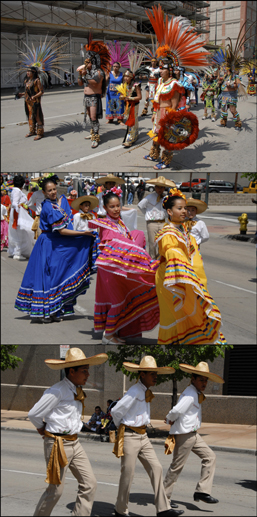Cinco de Mayo
Cinco de Mayo, the 5th of May in Spanish, is a Mexican regional holiday that, within Mexico, is celebrated primarily in the state of Puebla and the federal district but is also observed in other parts of Mexico. It has become a popular celebration of Mexican heritage in areas where the Mexican diaspora live, and because of this people sometimes mistakenly assume that it marks the date of Mexican independence. In reality, Mexican independence is celebrated on September 16 while Cinco de Mayo commemorates a later battle and victory by Mexican forces against a significantly larger force of French invaders at the city of Puebla on May 5th, 1862.
The Battle of Puebla
For more information, see the full article: Battle of Puebla
In July of 1861, Mexico's president Benito Juarez announced that all payments would be suspended on the substantial debt that the Mexican government owed to Spain, France, and England. This suspension was to be effective for at least two years. The lending nations were duly alarmed and dispatched soldiers to the port of Veracruz. The Mexican government negotiated a withdrawal of the Spanish and English forces, but French troops remained at Veracruz from where they were ordered to march on Mexico City in 1862.
The French encountered significant resistance at Puebla. There, Mexican General Ignacio Zaragoza held off three successive attacks by the French army, which was composed of some 6,000 cavalry and infantry, with 2,000 ill-equipped and poorly trained soldiers who were supported by the local populace. The last of the three battles took place on May 5th. Juarez declared Cinco de Mayo a national holiday on September 16th, the anniversary of the Grito de Dolores.
The French regrouped and launched a second campaign the following year with more than 25,000 troops. This effort met with more success and the army reached Mexico City in June of 1863. Maximilian of Hapsburg was installed as emperor of Mexico in April of 1864 but his reign was short, lasting only until 1867 after Napolean III withdrew his support and the Republicans retook Chapultepec Castle.
Observance
Mexican celebrations of Cinco de Mayo are mainly limited to the areas surrounding Puebla and Mexico City. Early celebrations are not well documented but one description does exist for a reconstruction that was staged in Peñón near Mexico City in 1933.[1] Celebrations are much more widespread in the United States among the Mexican diaspora than in Mexico itself.
United States
Cinco de Mayo celebrations became increasingly common in the United States at the end of the 20th century. A survey conducted in 1998 cataloged 120 celebrations dispersed over 21 states.[1]
References
- ↑ 1.0 1.1 Alvar W. Carlson. 1998. America's Growing Observance of Cinco de Mayo. Journal of American Culture 21(2): 7-16.
